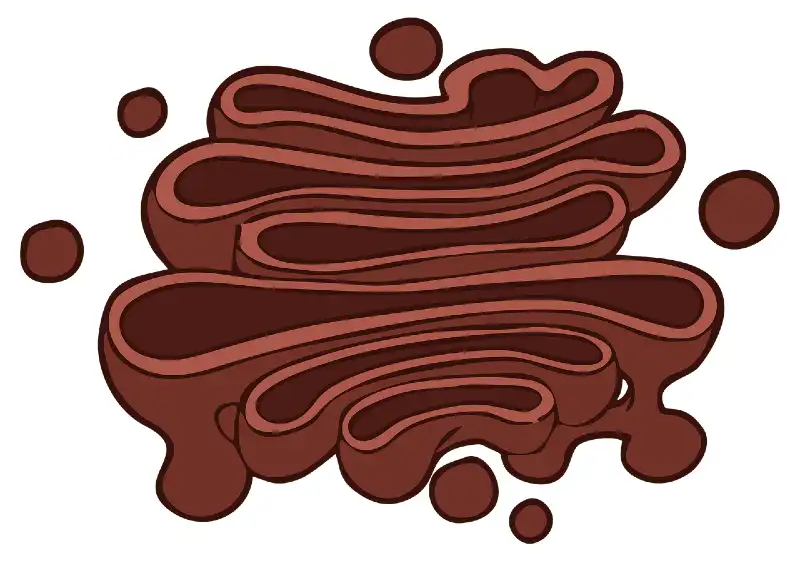Hello friends, in this article we will know what is Golgi complex, is and will also learn about it – Its Definition, Structure, Discovered, functions, etc. So let’s start without wasting time.
What is the Golgi complex?
Golgi complex definition –
The Golgi complex is a differentiated protein of the vacuolar system of the cell. Both morphological and functionally, it is related to the endoplasmic reticulum on one side and to the secretory vesicle on the other side.
Who discovered of Golgi complex?
It was discovered by Camillo Golgi in 1898 in the Nerve cells by the Silver staining method. After the Discoverer’s name, it is known as the Golgi complex, Golgi apparatus, or Golgi bodies.
Where is the Occurrence of the Golgi complex?
Golgi Complex occurs in all living cells except the prokaryotic cells and R. B. Cs mature sperm and sieve tubes in plants. In plant cells, it is known as dictyosome (Gr. dictyes: net).
Ultrastructure Golgi complex –
Golgi Complex comprises stacks of membrane-bound space which are of the following types :
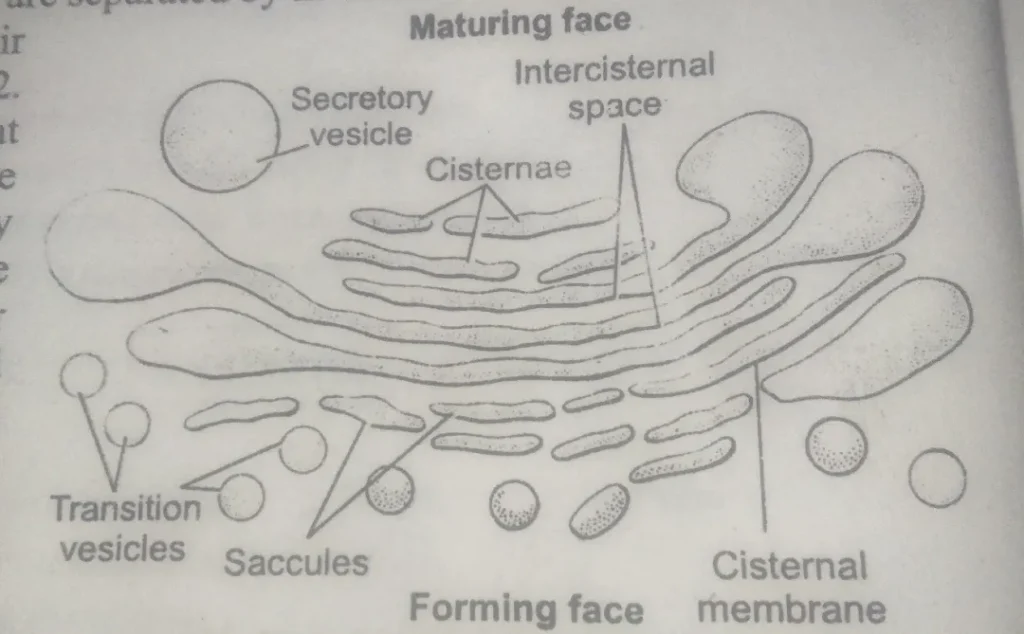
Cisternae –
Cisternae form the central plate-like Part of the Golgi complex. It consists of stacks of tubular or flattened compartments about 20 angstroms wide and enclosed by unit membranes.
These are stacked in parallel bundles one above the other and are separated by an intracisternal space of about 20 – 30 microns (200-300 angstrom).
Their number varies from 3-12. Cisternae are somewhat crescent and are arranged concentrically, with a convex surface towards the nuclear envelope or endoplasmic reticulum and a concave surface towards the plasma membrane.
Cisternae in a stack are arranged in a specific order. Those on the convex side are small.
This site represents the forming face of the Golgi apparatus. The transition vesicle and tubules that detach from the endoplasmic reticulum fuse here to create New cisternae.
The opposite concave face of the cisternal sack represents the maturing face. It is associated with secretory vesicles and vacuoles. These are formed by the Dilation of the ides of cisternae due to accumulation of secretory products formed by the concentration in Golgi cisternae. These vesicles coalesce and finally create large vacuolar structures that are called zymogen granules or lysosomes.
Transition vesicles –
These are small drop-like structures about 400 angstroms – 800 angstroms in diameter. These are associated with the convex forming face of Golgi cisternae and lie next to the smooth endoplasmic reticulum developed from the cisternae of Endoplasmic Reticulum and fuse to form Golgi cisternae. This region represents the zone of exclusion, a region of transition from the endoplasmic reticulum to the Golgi cisternae.
Secretory vesicles –
These are present on the side and on the maturing face of the Golgi. These are pinched off from the trans face of Golgi cisternae. These contain secretory products of Golgi and are finally converted into zymogen granules or lysosomes.
Coated vesicles –
In some cell types, the secretory vesicles are coated with a history layer of protein clathrin. These are called coated vesicles. These are associated with the secretion of highly specialized cellular products.
Golgi vacuoles –
These are large rounded presents on the maturing face of the Golgi. These are created either by the expanded cisternae or by the fusion of secretory vesicles. The vacuoles are filled with some amorphous or granular substance.
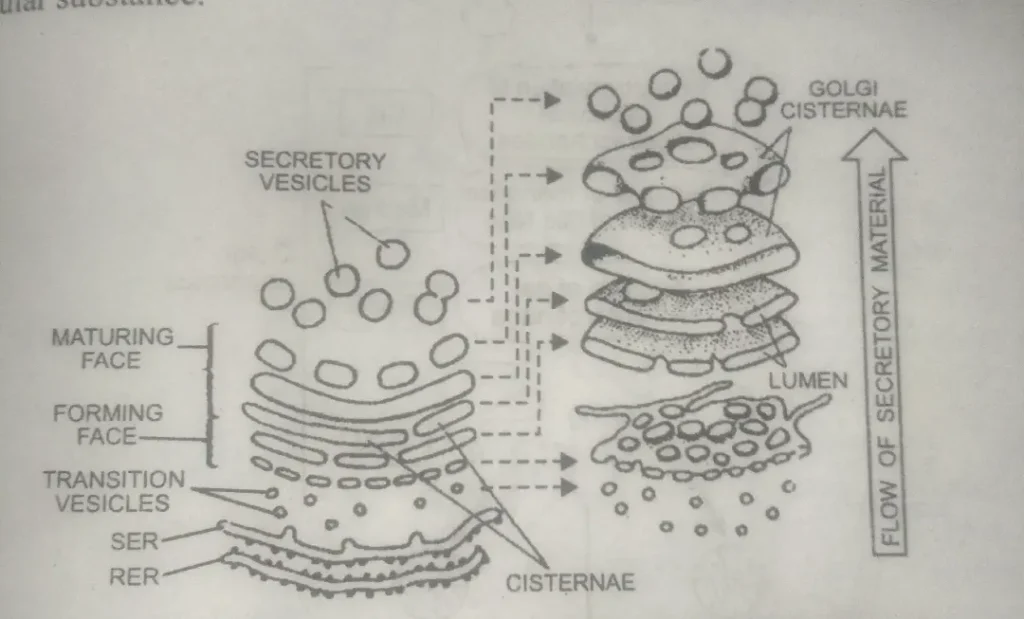
Polarity and membrane flow in Golgi –
The Golgi bodies are polarized structures. Their forming face lies close to the nuclear membrane or SER. Here, the new Golgi cisternae continue to be formed from the coalescing of transition vesicles.
On the maturing face or trans face, the cisternae break down into secretory vesicles or vacuoles, or zymogen granules. Thus, the two faces of Golgi are different.
The association of Golgi and Endoplasmic reticulum and lysosome is reflected in the GERL region (Where G-represent Golgi ER-endoplasmic reticulum and L-lysosome).
It is the region between the Golgi and plasma membrane where secretory vesicles are converted into zymogen granules by the concentration of products synthesized in RER.
What is the function of the Golgi complex?
The Golgi complex is of vital importance, as it performs a variety of functions in different types of cells. Some of them have been summarized in the following table.
Secretion –
Golgi are mainly associated with the secretory activity of the cell. Through the channels of the Golgi, there is continuous traffic of substances from the cell to the outside. These substances are synthesized elsewhere in the cells and concentrated and modify by the Golgi complex.
Finally, these are secreted outside. The secretion of various substances by Golgi in different types of cells has been summarized in the table. These include enzyme hormones, endocrine secretion, mucus, etc.
Concentration and storage of secretory product –
Golgi are associated with the concentration, storage, condensation, and Packaging of materials. The glycoprotein and lipoprotein are concentrated and packed in secretory vesicles which bud off from Golgi cisternae.
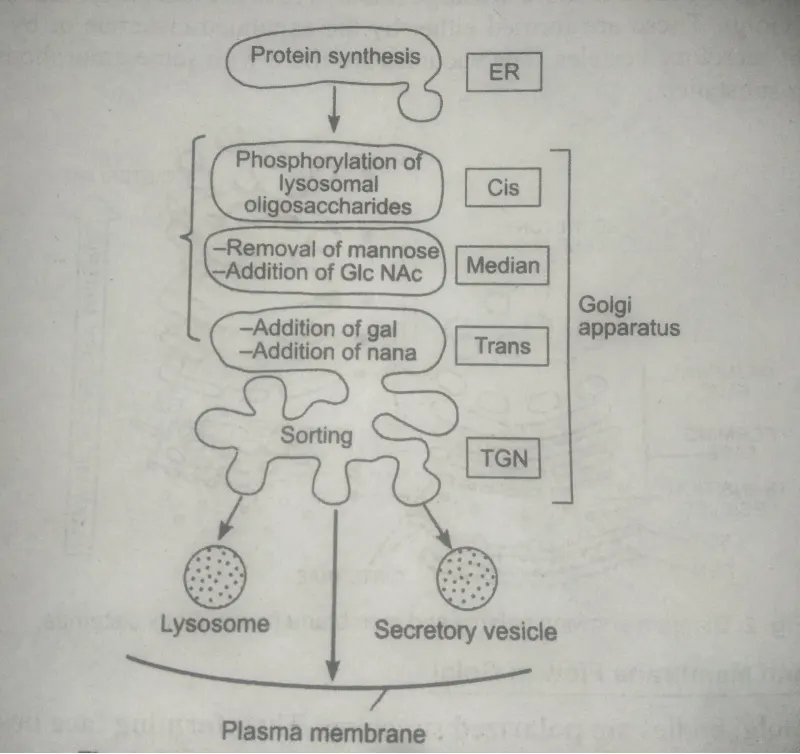
Formation of lysosome and vacuoles –
Primary lysosomes are formed from Golgi cisternae In the same way as the secretory vesicles.
Summary of functions of Golgi complex in different types of cells.
| Cell Type | Golgi Functions |
| Exocrine cells of the pancreas. | Secretion of zymogen (digestive enzymes-protease, lipase, carbohydrates, and nucleases). |
| Goblet cells of the intestinal mucosa | Secretion of mucus and zymogens. |
| Paneth cells of the intestine | Secretion of proteins. |
| Brunner’s glands of duodenum and ileum | Secretion of mucopolysaccharidoses and enzymes. |
| Hepatic cells of the liver | Transformation and secretion of lipids. |
| Follicle cells of the thyroid gland | Prothyglobulins (Hormones) |
| Plasma cells of blood | Immunoglobulins (hormones). |
| Cells of the alveolar epithelium of mammary glands. | Secretion of milk proteins. |
| Plant cells | Secretion of protein and cellulose. |
| Endothelial cells of blood vessels | Sulphation reactions. |
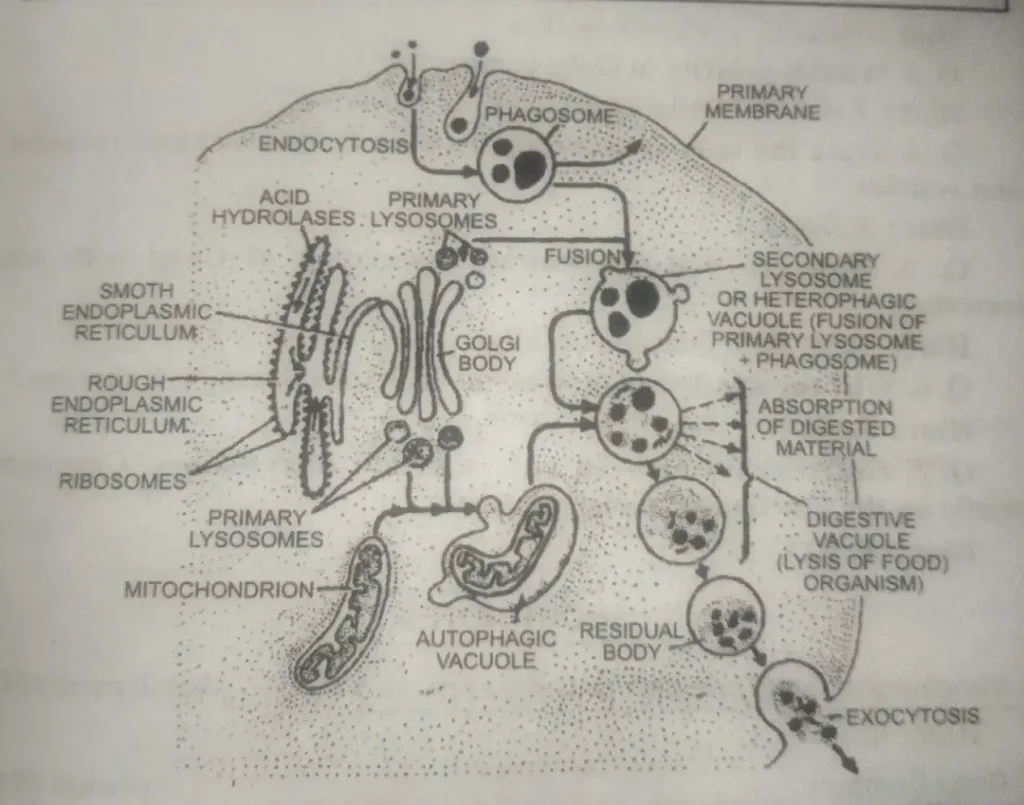
Synthesis of glycoproteins –
For some years, Golgi were believed to be a passive channel for the transportation of materials synthesized elsewhere in the cell. How you are now it is established that Golgi Facilitates the linking of carbohydrates and protein in the formation of glycoproteins.
Synthesis of carbohydrates –
The Golgi apparatus is considered to be the main agency for building large molecules of complex carbohydrates from simple sugars.
For example, in plant cells synthesis of protein and other carbohydrates and the formation of Polymucosaccharides etc. occurs Inside the Golgi.
Formation of cell plate –
The Golgi Complex produces vesicles during the anaphase of Mitosis. These vesicles fuse to form the cell plate.
The pectic material and other substances necessary for the formation of cell walls are synthesized and secreted by the Golgi complex.
Formation of acrosome –
The acrosome of sperm develops from the Golgi complex.
Formation of acrosome or role of Golgi body in spermatogenesis –
That form of spermatozoon is derived from the Golgi Complex of the spermatid.
In a spermatid, the Golgi complex is formed of numerous vesicles or small vacuoles in the center, surrounded by several rows of concentrically arranged cisternae. As the differentiation proceeds, the arrangement of cisternae becomes irregular and one or two vacuoles enlarge to replace the vesicles.
Inside each large vacuole appears a small dense body, of the acrosomal granule. The pro acrosomal granule and vacuole are formed of polysaccharides. If more than one vacuole and pro-acrosomal granules are formed, these fuse together so that only one is left in the end.
The vacuole with its acrosomal granule enlarges in size, migrates towards the anterior pole, and gets attached to the tip of the elongated nucleus, forming a sort of cap (cap’s stage). The pro-acrosomal granule enlarges further and forms the acrosomal granule.
It forms the core of the acrosome (acrosomal stage). The vacuole loses its liquid content and spreads over the acrosomal granule and half of the spermatozoon. It is known as the acrosome cap. The remainder of the Golgi body undergoes a gradual regression and is discarded as ‘Golgi rest’ together with the cytoplasm of the spermatid.
Friends, if you like the given information, then share it as much as possible.
Thank you
